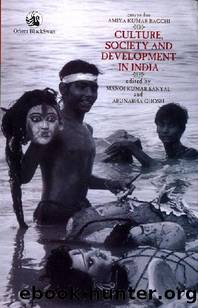Culture, Society and Development in India: Essays for Amiya Kumar Bagchi by Manoj Kumar Sanyal & Arunabha Ghosh

Author:Manoj Kumar Sanyal & Arunabha Ghosh [Sanyal, Manoj Kumar & Ghosh, Arunabha]
Language: eng
Format: epub
Publisher: Orient Blackswan
Published: 2009-06-02T00:00:00+00:00
SECULAR AND ANTI-ELITIST TRADITION IN MUSIC:
THE NAWABâS CONTRIBUTION
Wajid Ali Shah was a hedonist in his personal life. In his public life he earned a bad name for his lack of interest in governance and his surrender to the British without formidable resistance. But the way he tried to preserve and enrich the secular tradition of Indian art and, more importantly, his effort to break the elitist tradition of Hindustani classical music of addressing an extremely select audience are noteworthy. He broke the barrier of religion, and liberally borrowed themes from the Hindu religious tradition for his own compositions of musical verses.
Wajid Ali Shah was deeply moved by the raasjatra, which he witnessed at âBrijâ or Brindavan in 1843, and composed a musical verse entitled âRadha Krishna ka kissaâ.2 His fascination for raas has been mentioned in âGujishta Lucknowâ, authored by Abdul Halim Sharar (1975; 1971). In its stage production, the Nawab himself played the role of Krishna with his Begums as gopinis. In his durbar, he organised âIndersabhaâ3 for dance and music often based on the concept of raasjatra presented in the opera style.4 Sripantha (1990) describes Wajid Ali as a kathak dancer par excellence who often played a yogi (ascetic), clad in saffron, while the dancing girls of the court, who were affectionately called paris, took part as yoginis. The Nawab took lessons from kathak dancers Durga Prasad and Thakur Prasad who served in his court (Sharar 1975; Sripantha 1990). Durga Prasadâs sons, Bindadin Maharaj and Kalkaji, were also employed in his court. Bindadin Maharaj (1836â1917) is regarded as one of the most important figures in the development of thumri as well as kathak. He constructed the song form of thumri to accompany the interpretative portion of kathak. He learnt thumri from Sadiq Ali Khan and composed several arth-bhav thumris specifically designed for being rendered through dance (Sripantha 1990). At the Holi Utsav of 1867 in his Metiaburuj palace, the Nawab impersonated a female dancer. Eminent personalities from the music world in the city like Jadubhatta, Aghorenath Chakraborty (disciple of Murad Ali Khan and Ali Bux Khan), Sajjad Mohammed, Dhirendranath Basu (disciple of Karamatullah Khan) and Shyamlal Chakraborty were the invited guests in the audience (ibid.). The Nawabâs effort to popularise Hindustani classical music was not confined to the elite society of Calcutta; he was successful in inspiring a sizeable section of the music-loving people of the city to practise raga music or to become its connoisseurs.
The Nawab published in his pen name âAkhtarpiyaâ (jointly with his wife whose pen name was âAlamâ) three volumes of song texts composed by himself and his wife. They were mostly in the form of thumris and dadras (Sharar 1975; Sripantha 1990). Several of his thumris were outstanding, Babul mora naihar chhooto hi jaaye being his best-known musical verse. Interestingly, several composers of thumri also added âPiyaâ to their first names or surnames or assumed names, the most notable being âQadar Piyaâ (Mirza Ali Qadar), one of the Nawabâs close relations who stood by him till the end of his life in 1887.
Download
This site does not store any files on its server. We only index and link to content provided by other sites. Please contact the content providers to delete copyright contents if any and email us, we'll remove relevant links or contents immediately.
| Anthropology | Archaeology |
| Philosophy | Politics & Government |
| Social Sciences | Sociology |
| Women's Studies |
Cecilia; Or, Memoirs of an Heiress — Volume 1 by Fanny Burney(31333)
Cecilia; Or, Memoirs of an Heiress — Volume 3 by Fanny Burney(30934)
Cecilia; Or, Memoirs of an Heiress — Volume 2 by Fanny Burney(30889)
The Great Music City by Andrea Baker(21322)
We're Going to Need More Wine by Gabrielle Union(18074)
Bombshells: Glamour Girls of a Lifetime by Sullivan Steve(13109)
Pimp by Iceberg Slim(12933)
All the Missing Girls by Megan Miranda(12753)
Fifty Shades Freed by E L James(12451)
Norse Mythology by Gaiman Neil(11885)
Talking to Strangers by Malcolm Gladwell(11880)
Crazy Rich Asians by Kevin Kwan(8351)
Mindhunter: Inside the FBI's Elite Serial Crime Unit by John E. Douglas & Mark Olshaker(7835)
The Lost Art of Listening by Michael P. Nichols(6474)
Enlightenment Now: The Case for Reason, Science, Humanism, and Progress by Steven Pinker(6407)
Bad Blood by John Carreyrou(5770)
The Four Agreements by Don Miguel Ruiz(5511)
Weapons of Math Destruction by Cathy O'Neil(5038)
We Need to Talk by Celeste Headlee(4871)
